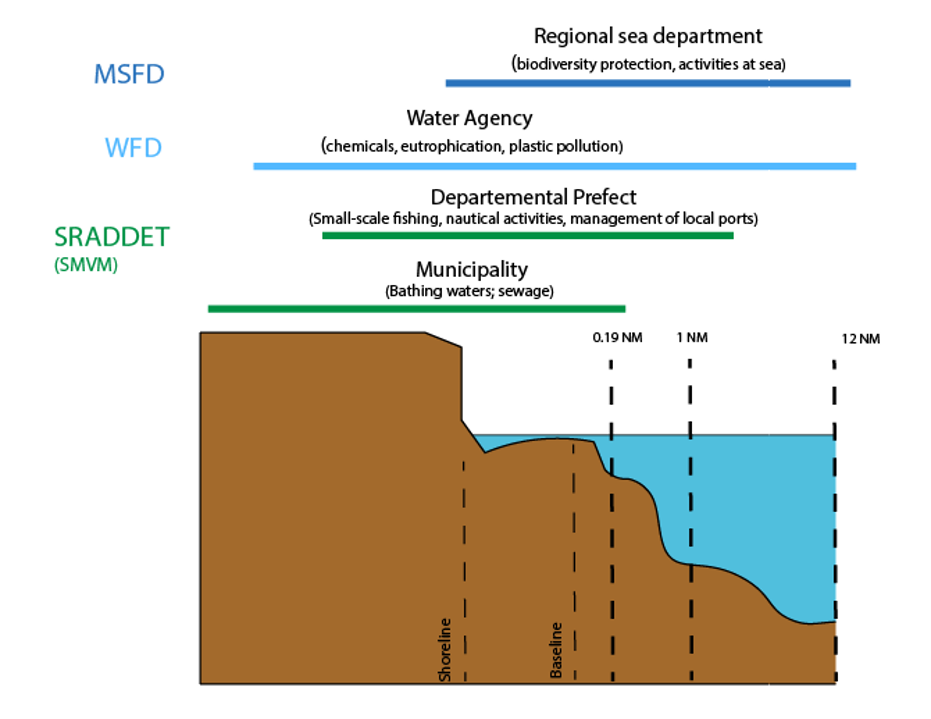The French Mediterranean case study provides an example of assessment of the coherence from source-to-sea concept.
The governance of this region is fragmented and complex, involving multiple planning documents and actors.
In the French Mediterranean Sea, 6 structural planning documents are applied. The maritime area is governed under a single maritime basin strategy, overlaid by two hydrographic basin plans and three regional land-based administrative entities.

Governance Challenges
Integration of planning instruments
- The Water Framework Directive (WFD) is implemented via River Basin Management Plans (RBMP).
- The Marine Strategy Framework Directive (MSFD) and Maritime Spatial Planning Directive (MSPD) are implemented in France through a unique planning document —the Document Stratégique de Façade (DSF).
- Finally, the Sea enhancement Scheme (SMVM), part of the land-planning document SRADDET (Regional plan for planning, sustainable development and territorial equality), serves as a coastal land-sea interface tool, enabling coastal municipalities to define local strategic orientations for the development of maritime economic activities.

Institutional repartition
Each planning document involves a range of stakeholders operating at national, regional, and local scales, with different objectives and scopes that can include biodiversity conservation, chemical and plastic pollution control, marine spatial planning, and management of public health concerns such as bathing water quality and wastewater treatment.

Cumulative Impacts challenging management
Governance complexities are further exacerbated when sectoral policies and plans—such as those for agriculture, industry, fisheries, tourism, and port infrastructure—interact with the aforementioned three main planning documents. These sectors often generate overlapping and cumulative impacts, particularly from freshwater inflows that can bring nutrients and agrochemicals, industrial pollution, and widespread plastic waste.
Marine sectors such as fisheries, maritime transport, and tourism, along with land-based infrastructure development and urban planning, add further layers of pressure. These sectors are frequently governed by distinct policies and managed by separate institutions, resulting in policy fragmentation and coordination challenges.
For instance, in the case of agriculture and plastic pollution, a total of 14 different institutions may be involved in the management of identical issue. These institutions may be different on land and at sea. This fragmentation creates barriers to integrated management and complicates the establishment of coherent coordination mechanisms.
At the local scale, a small municipality with a populations of approximately 50,000 inhabitants may be required to comply with 8 to 10 different planning documents related to coastal management. Such administrative complexity can result in incoherent policy implementation and, in some cases, disengagement or withdrawal of local actors from the governance process altogether.
Successful coordination mechanisms in the coastal area
Following the adoption of the MSFD and later, the MSPD, France made two strategic decisions:
- To establish a single integrated planning document—the Document Stratégique de Façade (DSF)—covering the marine basin strategy and implementation mechanism (integrating MSFD and MSPD.
- To leave the chemicals and eutrophication issues to the institution managing the RBMP, thereby reinforcing land-sea continuity and alignment of objectives.
Key successful mechanisms have been implemented to support the coherence between freshwater and marine planning document; land planning document still being still siloed and less connected to the marine environment. These mechanisms lay at different stages: during the policy drafting, in the institutional dialogue, in implementation tools and in the data knowledge system.
Policy Drafting
A key success of integration in the coastal area lies in the coherence assessment of planning documents. Prior to publication, all strategic documents undergo a mandatory review to ensure consistency across governance frameworks. The Water Agency is actively involved in the drafting of the MSFD/MSPD planning document, participating in the formulation of shared objectives and priorities. This reciprocal engagement facilitates a more systemic and collaborative policy development process.
Institutional dialogue
Beyond the drafting phase, institutional coordination continues through regular inter-agency meetings and coordination. Institutions involved in the implementation of the WFD and MSFD/MSPD meet twice per year:
- once during a Mediterranean strategic meeting involving more than 50 institutions and experts
- bilaterally for technical issues (such as restoration) to discuss more in detail the programs of measures.
An interesting fact specific to the French mediterranean Sea, is that the Water Agency is strongly involved in the management of the marine environment. They have dedicated service to marine coastal areas since 2012. They also have a freshwater coastal committee for coastal municipalities to give them advice on how to protect the marine environment.
Implementation mechanisms
WFD and MSFD/MSPD have common implementation mechanisms. Their programs of measures are now mutually supportive, with cross-references in their measures and indicators tables ensuring alignment. Since 2023, marine and freshwater institutions have implemented yearly joint calls for project funding, covering areas such as coastal and marine restoration.
Data knowledge and platforms
Since 2018, efforts have been made to harmonise environmental indicators across the marine and freshwater policies, indicators and assesments. Since 2024, a common data platform has been established to support both the MSFD and the RBMP. This platform enables the integration of scientific assessments, with the Water Agency responsible for monitoring and reporting on pollution and eutrophication under the MSFD.
Ways forward
Despite these national-level advancements, local governance of coastal areas remains challenging.
As previously mentioned, the local actors suffer from a lot of difficulties and challenges in terms of governance of the coastal areas. To address this, and under the impulsion of both the Water Agency and the Marine institutions, two complementary local planning instruments were recently introduced. They compile actions to be taken to prevent degradation and restore the marine environment, in line with actions to reduce pollutant inputs to the sea. They are managed through a volunteer contractual arrangement involving municipalities, regional institution managing RBMP, marine and land policies.